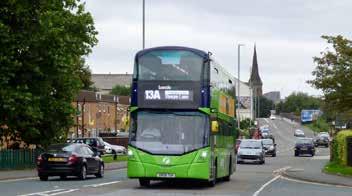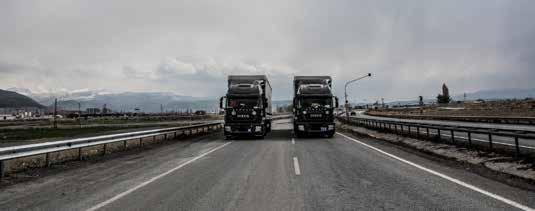
12 minute read
News
in brief
EVs at COP26 hampered by lack of charging points
Advertisement
Electric vehicles (EVs) at COP26 could be powered by external combustion generators due to a lack of available charging points, according to AFC Energy. The company has said that the UK has missed an opportunity to showcase our climate credentials to the global community. The UK is projected to have over 23 million EVs by 2030; amounting to the equivalent electricity usage of powering every UK household for two months. However, AFC has warned that insufficient investment in appropriate EV infrastructure could lead to power shortages across the grid and continue to exacerbate the UK’s reliance on polluting generators.
New project will raise investment to install 280 EV charge points
EZ-Charge is raising finance to install 280 electric vehicle (EV) charging points in public car parks across Oxfordshire. The money will be used to: • Develop the Oxfordshire Park &
Charge project in local authority car parks, facilitating over 2,800
EVs from year 1. • Accelerate the adoption of EVs • Share their expertise and technology • Continue to develop state of the art charging technology, creating jobs and economic benefits for
Oxfordshire. Infrastructure works will begin on November 1st 2021 with all charge points live by the end of February 2022.
New software will improve the energy efficiency of EVs
Thanks to £400,000 worth of funding from Innovate UK, Hypermile and Spark EV technology will develop their Co-pilot software solution. The software uses computer vision and artificial intelligence to assess when it is best suited for the vehicle to coast – using no energy – and when to maximise the percentage of breaking. The software will also use Spark EV’s range prediction technology to analyse real-world variables such as traffic, weather and driver behaviour to provide accurate data on how far the vehicle can travel before needing to be recharged.
Leeds outlines plans for a future where you ‘don’t need a car’
Following on from £380m worth of infrastructure improvements, Leeds City Council has set out further plans to transform transport over the next 10 years.
The aim of the Connecting Leeds Transport Strategy is to create a city where you don’t need a car, and where everyone has access to affordable, low carbon and healthy transport choices. The new plans involve: • Reducing CO2 emissions from transport by 43% by 2030 • Reducing car mileage by 30% and increasing bus usage by 130% • Completing the first phase of investment in public transport • Understanding how travel patterns have changed during the Covid-19 pandemic • Reviewing policies on road space reallocation • Working alongside the Mayor and West Yorkshire Combined
Authority to secure more government funding • Continuing with travel behaviour initiatives
The majority of public consultation responses endorsed the approach, from over 1,700 responses, 70% agreed with the levels of ambition and vision.
The feedback also found that more needs to be done to reduce transport carbon emissions, but promisingly 58% of replies said they are willing to change to a lower carbon mode.
Leeds City Council Leader Cllr James Lewis, said: ‘This transport strategy will enable Leeds to retain its role as a local, regional, and national transport hub and prepare the city for the arrival of high-speed rail.
‘We will continue to work and support the newly elected Mayor, alongside our joint efforts to transform the bus network. Maximising the transport investment, our approach will ensure benefits are distributed across the city and wider city region.
Living near an oil or gas well increases air pollution exposure
Researchers at Stanford University analysed local air quality measurements at 38,000 wells that were being drilled and 90,000 wells in production between 2006 and 2019.

They found that all of the wells were emitting toxic levels of particulate matter (PM2.5), carbon monoxide, nitrous oxide, ozone and volatile organic compounds (VOCs).
When a new well is being drilled, PM2.5 increases by 2ug/ m3 about a mile away from the site.
The research also revealed that ozone was present up to 2.5 miles from the wells.
With at least two million Californians living within one mile of an active oil or gas well, the researchers have highlighted that this is a serious cause for concern.
Senior study author Marshall Burke said: ‘It’s really hard to show air quality impacts of an activity like oil and gas production at a population scale, but that’s the scale we need to be able to infer health impacts.
‘While it’s not necessarily surprising that drilling and operating oil and gas wells emit air pollutants, knowing the magnitude of the effect improves our broader understanding of who is exposed to what and how to intervene to improve health outcomes.’
European policy lags behind truckmakers on CO2 emission
The European Union is failing to set adequate emission reduction targets for truckmakers, a new study shows.

According to the study, which was published by the campaign group Transport & Environment (T&E), improvements in fuel efficiency mean trucks can already achieve the EU’s 2025 CO2 reduction target while producing just a few zero-emission vehicles.
The study reveals that most truckmakers have made voluntary commitments for electric sales which go beyond what the EU requires.
According to public announcements, these voluntary commitments would take the market to around 7% zeroemission vehicles in 2025 and 43% in 2030 - higher than the 2% needed in 2025 to meet existing voluntary targets. These voluntary announcements show that the EU can set a realistic - but more ambitious – target of at least 30% zero-emission trucks by 2028, says T&E.
Average CO2 emissions for new long-haul trucks were higher in larger western European countries such as France, Germany and the United Kingdom, while smaller countries such as Bulgaria, Estonia, Portugal and Slovakia performed significantly better. Poland’s long-haul truck emissions, for example, are 3.5% below the EU average while Germany’s are 2.2% above.
Lucien Mathieu, acting freight director at T&E, said: ‘Truckmakers are going green quicker than policymakers, which is absurd. However, this is not the case of the free-market doing its job, but rather policymakers failing to do theirs. Truckmakers are clearly able to decarbonise quicker. It’s time to make them.
Children from poorer backgrounds more likely to develop persistent asthma
Children experiencing social disadvantage in their first few years of life have a greatly increased risk of asthma persisting into adulthood, a study has found.
The study, published in the journal Thorax by University of Liverpool and Imperial College London researchers, looked at the early life circumstances of thousands of UK children and their risk for persistent asthma as teenagers, using data from almost 7,500 children born in the UK between 2000-2002.
Comparing the relative impacts of a range of early life circumstances on asthma risk (such as birth weight, parental smoking, quality of housing and neighbourhood), their analysis found that being born into disadvantaged circumstances increased the likelihood of developing persistent asthma by 70%, with almost two-thirds (59%) of the risk attributable to early life exposures; before the children reached three years old.
The researchers say their findings highlight how social and economic factors are driving persistent asthma among the most disadvantaged children in the UK.
They add that while the condition is manageable, persistent asthma is still responsible for preventable hospitalisations and deaths, and that the UK has among the worst death rates for asthma in Europe.
‘We know that children from poorer backgrounds, who live in disadvantaged circumstances, tend to have a much higher risk of developing asthma, but they also have more asthma attacks, hospitalisations and are more likely to die from asthma,’' said Sonia Saxena, professor of primary care within Imperial’s School of Public Health.
in briefin brief
BAME communities are more likely to live in areas with toxic air
Black, Asian and Minority Ethnic communities in London are more likely to live in areas with toxic air, new data reveals. In light of this data, Sadiq Khan has launched a new Breathe London community programme to reduce this pollution. Sadiq Khan, said: ‘We know toxic air pollution in London stunts the growth of children’s lungs and worsens chronic illnesses, such as asthma. Now our new research confirms that those exposed to the worst air pollution are more likely to be Londoners living in deprived areas and Black, Asian and Minority Ethnic communities.’
Air pollution linked to increased mortality
Researchers from the Harvard School of Public Health found that each 1g/ m3 increase in annual particulate matter (PM2.5) concentrations increased the absolute annual risk of death by 0.073%. Each 1 ppb increase in annual nitrogen dioxide (NO2) concentrations increased the annual risk of death by 0.003%, and each 1 ppb increase in summer ozone (O3) concentrations increased the annual risk of death by 0.081% These increases translated to approximately 11,540 deaths attributable to PM2.5, 1,176 deaths attributable to NO2, and 15,115 deaths attributable to O3 per year for each unit increase in pollution concentrations
New air quality alert system launched in Northern Ireland
Northern Ireland has announced changes to the Air Pollution Alert Protocol to improve public awareness during periods of high air pollution. Changes will include the use of social media to disseminate information about high levels of air pollution to the public, health professionals and those in high-risk groups. Edwin Poots, Northern Ireland’s Environment Minister said: ‘Interest in the quality of the air we breathe has grown massively over recent years, and the improvement of this alert system allows people with underlying health issues, such as heart and lung conditions or asthma, to get more localised information when they need it.’
in brief
UK’s first ever EV battery recycling facility to open in Sheffield
RSBruce have launched the UK’s first-ever lithium-ion battery recycling service. According to the University of Warwick, it is expected that from 2035 every new passenger car sold across the country will be electric and will have a lithium-ion battery, and it is predicted that by 2040, 339,000 tonnes of these batteries will reach end of life. Recognising the potential this offers to UK based recycling specialists, RSBruce has invested in new equipment to offer whole life cycle lithium-ion battery recycling services completely in-house.
Air pollution linked to lower exam results
Exposure to air pollution is linked to lower cognitive performance, according to a new study published by the University of Chicago. The researchers analysed data on ozone (O3) and particulate matter (PM2.5) pollution and a data set of students’ scores to examine the impact of air pollution on academic performance. The findings suggest that an increase of 10mg/m3 of particulate matter on the day of the examination decreases students scores by 8%. Consistent with previous studies, the authors also found evidence that the effect of air pollution on exam performance appears to affect males more adversely than females.
Wales to introduce air quality speed cameras
A series of speed cameras will be introduced in Wales in a bid to reduce air pollution. Unlike the majority of speed cameras that are located in areas with a high number of serious collisions, these new cameras will be located in areas that have poor air quality and will aim to smooth traffic flow in order to reduce emissions. In 2018, the Welsh government introduced a series of 50mph speed limits on some of the most polluted roads, this helped to reduce pollution by up to 47%. The Welsh Government is looking to maximise these benefits by enforcing the limits using Jenoptik SPECS average speed cameras.
Air pollution is linked to childhood pneumonia
Air pollution is associated with 2 million additional pneumonia cases in children under 5 in South Asia, according to a new study led by Stanford University.
The researchers analysed data on particulate matter (PM2.5) pollution alongside community health surveillance data in Dhaka, Bangladesh.
They found that pneumonia incidence among children under 5 increased by 3.2% for every 10µg/m3 increase in PM2.5 pollution.
The mean PM2.5 level in Dhaka was on average over three times higher than the World Health Organization standard. The researchers have therefore suggested that the association between air pollution and child pneumonia suggests that air pollution is a major contributor to the leading cause of child death in Bangladesh and across South Asia.
These findings are also approximately double that of prior estimates of pneumonia hospitalisations associated with increased PM2.5.
The researchers have said that the difference from previous findings may reflect the young age of the study population - most children in the study were two or younger.
Allison Sherris, a postdoctoral research fellow in Earth System Science at Stanford’s School of Earth, Energy & Environmental Sciences said: ‘Everybody wants to protect kids’ health. Now, we have evidence of a clear health benefit to children from reducing ambient PM2.5 emissions in Dhaka.
‘Specifying the impact of industry-generated air pollution on child health provides compelling evidence to support interventions to reduce pollution.’

Mayor of London prioritises active travel and urban greening
New guidance sets out the Mayor of London’s vision for a sustainable future, ensuring developments in the capital are greener, more energy-efficient and prioritise space for walkers, cyclists, and public transport.
The regulations include ‘Be Seen Energy Monitoring’, which requires monitoring and reporting of the actual operational energy performance of buildings forming part of major developments for at least five years post-construction, creating a better understanding of ‘real world’ energy use rather than predictions during the design stage.
The Mayor has also introduced ‘Urban Greening Factor’ guidance, which sets out how new developments should calculate their urban greening score, encouraging the inclusion of natural vegetation such as woodland or intensive green roofs in development plans, as well as rain gardens and flowerrich planting.
The plans also include new guidance on sustainable transport, walking and cycling, ensuring enough space is dedicated to sustainable travel when building new developments, such as creating new walking routes and improving the cycle network.
The new guidance forms a material consideration when it comes to planning decisions and developing planning documents, such as a borough’s Local Plan.
The Mayor of London, Sadiq Khan, said: ‘I’m committed to making London a zero-carbon city by 2030 and delivering a brighter future for London – one that’s greener, fairer and more prosperous for everyone.
That’s why I’ve developed these new pieces of guidance, building on the ambitious targets in my London Plan, that will ensure new developments in London prioritise urban greening and make space for sustainable transport like walking, cycling and public transport.








